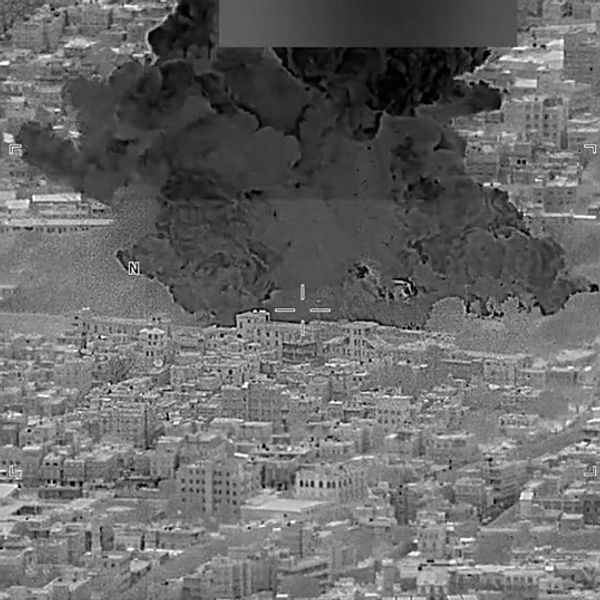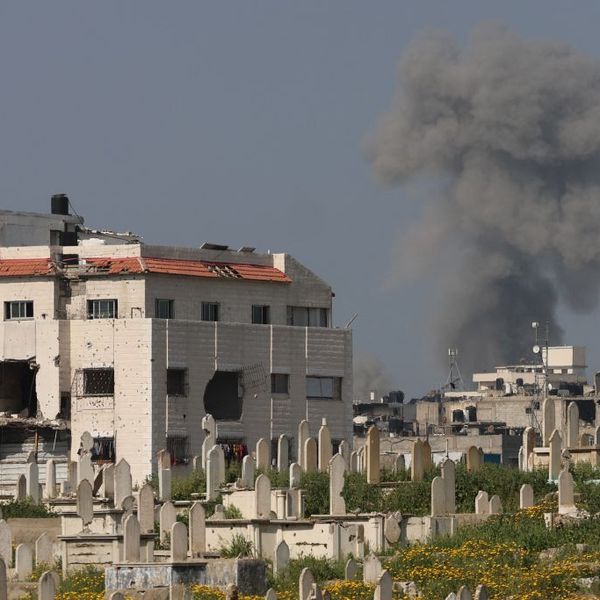OPINION — How long can the U.S. support an unpopular war in a foreign land? A decades-long relationship could be in danger. A key U.S. ally in the Middle East is bombing its neighbors, making heavy use of U.S.-built weapons to hit militants it calls terrorists—but also killing some civilians and sparking what looks like a famine. America certainly supports its ally and opposes terrorism, but can this brutal war be allowed to continue? Surely, a cease fire followed by negotiations is the only way to ensure a calmer, more peaceful future.
The year is 2018, the conflict is in Yemen, and the U.S. ally is Saudi Arabia, which is trying to push back against Iran-backed Houthi rebels, who seized the capital in 2014. What happened next should be studied closely by anyone who thinks a cease fire in Israel’s war on Hamas in Gaza will pave the way for a more peaceful future, or bring an end to Palestinians’ suffering.
A Saudi-led Arab coalition began a campaign to roll back the Houthi rebels in 2015. It started with an Emirati-run mission to save Yemen’s second city and interim capital, Aden, from conquest by the Houthis. In the years that followed, the coalition waged a counteroffensive which liberated most of the southern half of Yemen. However, the Arab coalition’s airstrikes killed significant numbers of Yemeni civilians; this was the result of the coalition forces’ inexperience, the fog of war in difficult terrain, and the cynical exploitation of the first two by the Houthis, who hid their military assets among civilians.
By 2018, the Arab coalition was closing in on the critical port of Hudaydah. Positioned on the Red Sea, along the Western coast of Yemen, Hudaydah served as the Houthis’ lifeline for revenue and supplies. Experienced and well-respected analysts predicted that the Houthi regime could fall within a month if the Arab coalition recaptured Hudaydah from the group. But humanitarian organizations argued that fighting in Hudaydah would disrupt the delivery of international aid. In light of their claims that Yemen was on the brink of humanitarian catastrophe, Western governments and international humanitarian organizations pressed the coalition to stand down. This left Hudaydah under Houthi control.
It's not just for the President anymore. Cipher BriefSubscriber+Members have access to their own Open Source Daily Brief, keeping you up to date on global events impacting national security. It pays to be a Subscriber+Member.
Under intense Western pressure, the Arab coalition entered into the Hudaydah Agreement, brokered by the UN. This required the Houthis to withdraw from the port and hand it over to a neutral third-party so that revenues from the port could be used to pay the salaries of government employees, such as teachers, throughout Yemen. In practice, despite the ceremonial “withdrawal” of Houthi forces from Hudaydah port, the Iran-backed regime enjoyed the protection of the agreement without abiding by its commitments. The Houthis maintain absolute control over Hudaydah port and have yet to share any of its revenues to pay for government salaries. Instead of ending the war, the Houthis expanded it, targeting energy and transport infrastructure in Saudi Arabia and the UAE with long-range drones and missiles.
As this happens, the UN continues to pay for the rehabilitation of Hudaydah port and the training of its staff – essentially subsidizing the lifeline of the Houthi war machine.
The Biden Administration adopted policies which sought to pressure the Saudis to end their involvement in the Yemen war. In February 2021, the newly-elected president stated “This war has to end…We are ending all American support for [Saudi] offensive operations in the war in Yemen including relevant arms sales.” This was a grave misreading of the situation. It complicated Saudi efforts to extricate themselves from the conflict; by making Riyadh more desperate and providing Sanaa with more momentum, the talks have transformed into a drawn-out negotiation of Saudi surrender. Saudi Arabia is now negotiating an agreement in which it is expected to agree to pay into a fund which will be used, in part, to pay for the salaries of Houthi government employees, including the same Houthi military that has been attacking them, as part of a broader Yemen peace deal.
The foolishness of the peace-at-any-cost approach to the Yemen war was demonstrated in November of last year, when the Houthis began their relentless campaign of attacks on civilian commercial traffic in the Red Sea. Nominally aimed at first at Israeli-linked shipping, this quickly grew into a blackmail and extortion campaign directed at the world—or more precisely, at the free world, as Russian and Chinese ships are not (intentionally) attacked. The Houthis claim that they will stop if the “war on Gaza” ends—but their continued missile and drone attacks on Saudi Arabia and the UAE even after the Hudaydah Agreement suggest that the threat is not going away any time soon. And both the UAE and Saudi Arabia seem reluctant to cooperate with U.S. efforts to combat the Houthis militarily, having been burned by the U.S. before.
Who’s Reading this? More than 500K of the most influential national security experts in the world. Need full access to what the Experts are reading?
The parallels with Hamas in Rafah are clear and ominous. The Rafah border crossing is a major commercial artery. Control of this artery gives Hamas the ability to tax goods coming in and out of Gaza, as well as to block the exit of dissidents and opponents. Hamas is perfectly willing to create a humanitarian catastrophe as it defends its chokehold on Gaza—but allowing it to keep control means submitting to its forever war against the existence of Israel, and its constant efforts to humiliate the West and moderate Arab states. Any agreement with Hamas to facilitate some kind of compromise over the Rafah crossing is likely to turn out like the Hudaydah Agreement, a fig leaf for continued militant control that prioritizes war above all else, and treats humanitarian concerns as an opportunity for profiteering and propaganda.
Where did the U.S. approach to these conflicts go wrong? One might be tempted to start by looking at the Houthis’ famous war-cry, which they call “the scream.” It goes like this: “Death to America! Death to Israel! A Curse on the Jews! Victory to Islam!” An organization which makes fanaticism and the extermination of enemies the core of its identity is a poor candidate for compromise. The parallels to Hamas’ infamous charter, with its calls to kill all Jews everywhere, are obvious. And the education of young children to hatred and martyrdom, the military training camps for young teenagers, and the militarization of society in Gaza and Houthi-held Yemen are almost interchangeable.
But fanaticism is only a partial explanation for what Hamas and the Houthis are doing. The truth is that their behavior makes a great deal of sense given their strategic positions. These are groups that have mortgaged all of their prestige on unwinnable and extremely brutal wars. Moreover, their leaders have little experience with or interest in peaceful economic development or fostering a society based on personal freedom. Their struggle against the West has no end on the horizon. Before signing on to a cease fire with groups like these, we need to see a “cease fire” the way they do—as a temporary pause until they can gather more forces, develop more weapons, devise new tactics, and then break the cease fire with a surprise attack, to initiate yet another battle in their campaigns of conquest.
There may of course be circumstances in which a temporary pause in fighting could make sense for humanitarian, political or even military reasons. But the drive for a cease fire cannot be based on a naive hope for compromise or some remote hope that these groups will abandon their stated aims. When facing an enemy whose strategy is permanent war, and whose tactics are to exploit human suffering, then a strategy based on negotiations and goodwill is itself a betrayal of humanitarian principles. Any deal which the Houthis or Hamas are offering is a deal which they see as enhancing their long-term ability to achieve their extremist and dangerous ends. The only way forward is to change the reality on the ground so as to degrade these groups’ military capabilities, and, perhaps more importantly, to prevent them from stealing aid, tightening their stranglehold on the societies under their rule, and otherwise advancing their brutal aims.
The Cipher Brief is committed to publishing a range of perspectives on national security issues submitted by deeply experienced national security professionals. Opinions expressed are those of the author and do not represent the views or opinions of The Cipher Brief.
Have a perspective to share based on your experience in the national security field? Send it to Editor@thecipherbrief.com for publication consideration.
Read more expert-driven national security insights, perspective and analysis in The Cipher Brief










